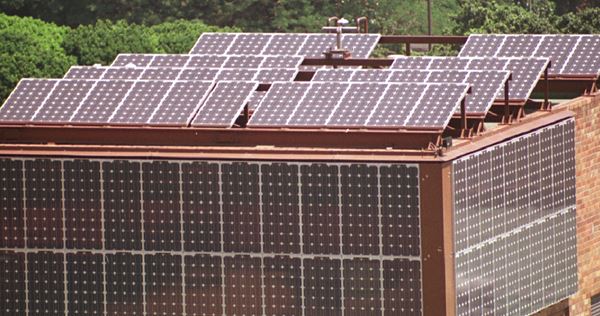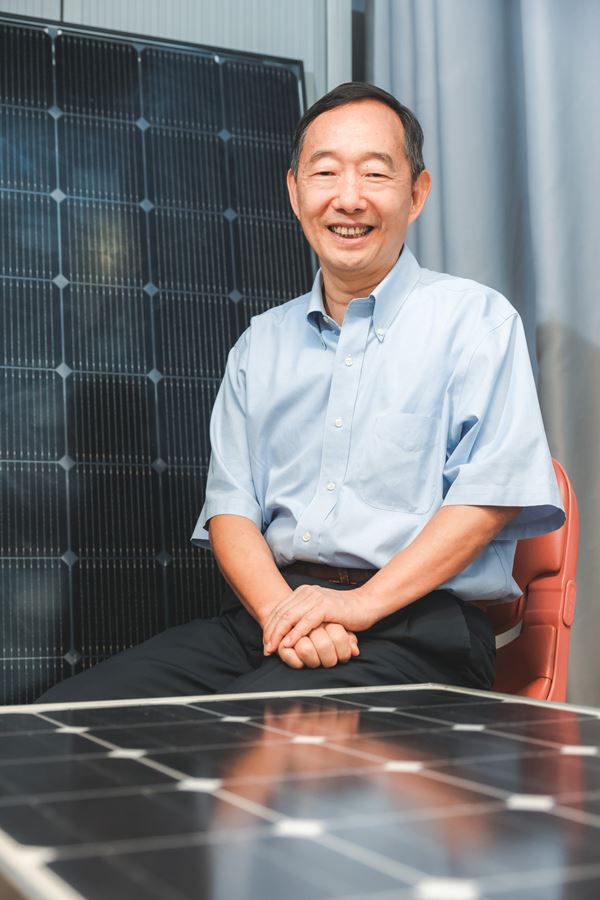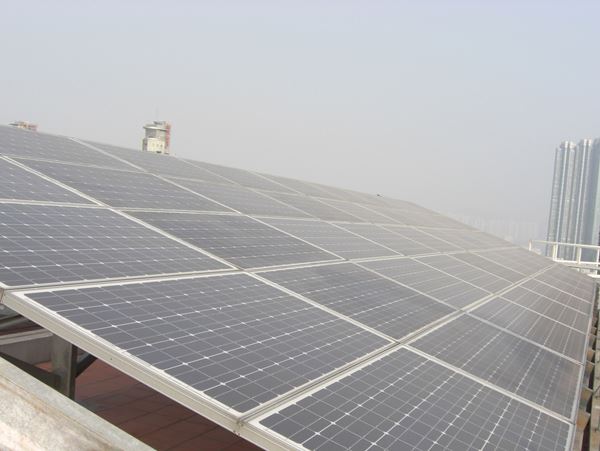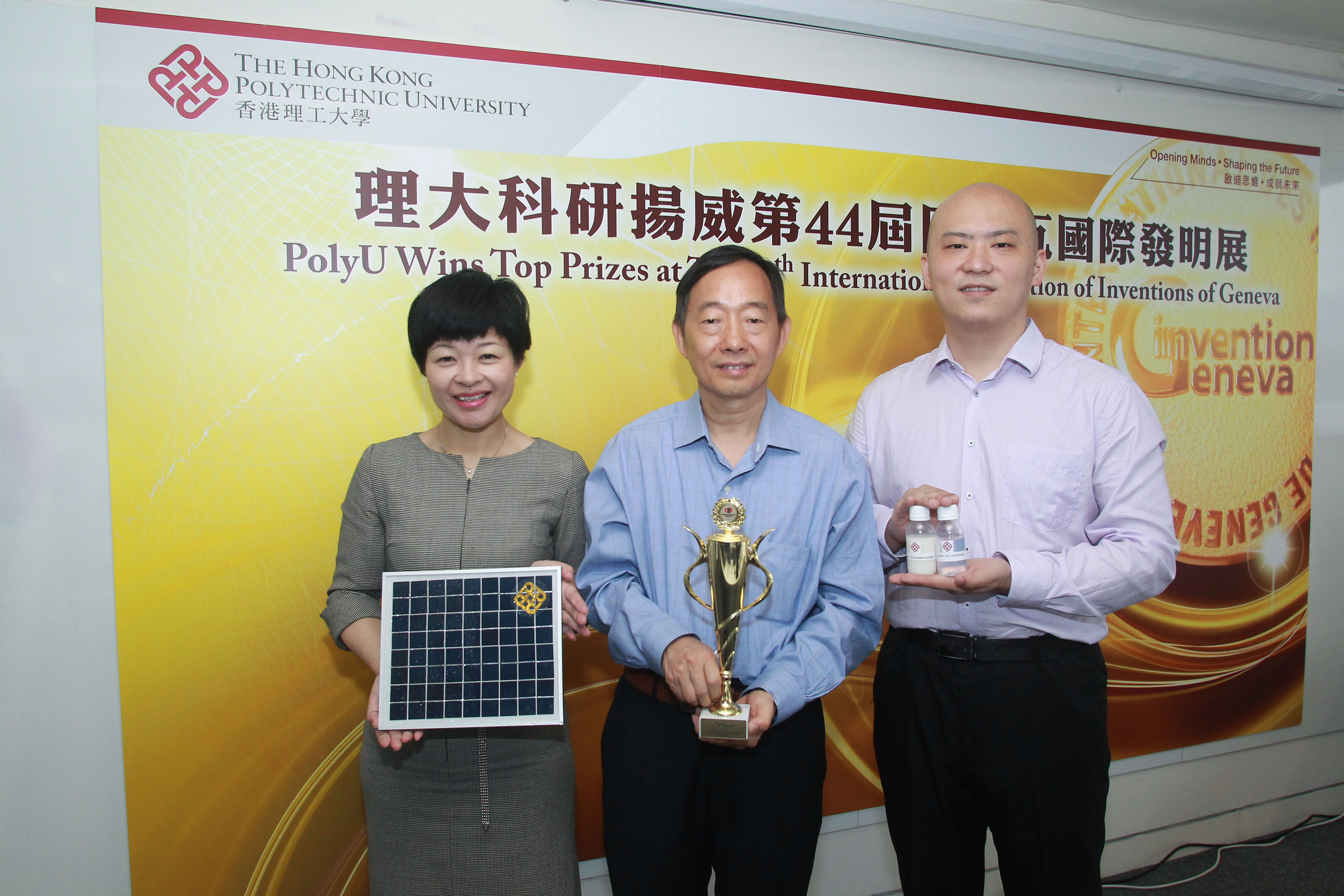The Pioneer of Solar Energy Application – Building Integrated Photovoltaics
In Hong Kong, buildings account for over 90% of electricity usage, creating over 60% of the city's carbon emissions. One of the critical measures to achieve the carbon neutrality target is to reduce coal-fired and natural gas-fired electricity generation, while increasing the proportion of electricity production from renewable energy. As a pioneer in renewable energy research, PolyU spares no effort in developing relevant technologies with applications and testing on the campus. A good example is the installation of solar photovoltaic systems at the Lee Shau Kee Building (Y-Block).
“Due to the high land price in Hong Kong, it is impossible to mount photovoltaic solar panels on the ground as in mainland China,” says Professor Yang Hong-xing from the Department of Building Environment and Energy Engineering of PolyU, who has been conducting research on renewable energy applications for more than 30 years. “Therefore, we have to adopt the building-integrated photovoltaic (BIPV) technology here. By integrating photovoltaics into the building envelope on a massive scale, we will be able to minimise carbon emissions and create a green campus.”
Currently natural gas dominates the fuel mix for electricity generation in Hong Kong at around 50%, and coal, with high carbon emissions and causing high levels of pollution, accounts for 25%. Non-fossil fuels, including imported nuclear power and renewable energy, only account for a quarter, but less than 1% from renewable energies. We are particularly lagging behind other developed countries like Japan and Germany in adopting solar energy and wind energy, and there is even no comparison with mainland China.
Therefore, the “Towards a Better Hong Kong: Pathways to Net Zero Carbon Emissions by 2050” report published by the HKSAR Government urges to take an active stance in adjusting the electricity generation fuel mix, including a substantially increased share of renewable energy sources to eliminate 70% of carbon emissions. The report also refers to a PolyU research report which suggests that 10% of electricity in Hong Kong can be generated from renewable energy sources, including solar and wind power.
“Since coming on board at PolyU in 1995, I began to develop experimental systems on solar photovoltaic integration in buildings,” says Professor Yang, who set up Hong Kong’s first BIPV experimental system on the PolyU campus in 1999. An 8-kilowatt photovoltaic system was installed on the roof water tank of Shaw Amenities Building (Block VA) to absorb energy from the sunlight for power generation. Later, the same kind of device was also installed on the roof of Tang Ping Yuan Building (Block F-C) for testing different kinds of BIPV systems.
Leading projects implemented on the PolyU campus not only brought demonstrative effects to the society, but also raised the attention of the Government and the industry, and attracted many visitors to the sites. More BIPV systems were consequently set up in different locations of Hong Kong by the Government and industrial organisations, which further demonstrated how BIPV works. Since then, Professor Yang has helped design and install BIPV systems for various development projects at the Kadoorie Farm, the Hong Kong Jockey Club and Ma Wan Park. This significantly promoted BIPV and drove the development of renewable energy technologies in the territory.

Professor Yang Hongxing has been contributing to the development of building-integrated photovoltaics (BIPV) applications and the promotion of clean, eco-friendly renewable energy on the PolyU campus since the 1990s. As shown in the picture, supported by Campus Facilities and Sustainability Office and Campus Development Office, a BIPV system was installed on the roof of the Shaw Amenities Building, which was a “temporary building” for testing and was finally disassembled in 2016 after the testing was completed
In line with PolyU’s motto “To learn and to apply, for the benefit of mankind”, Professor Yang not only strives to extend the frontiers of science but also emphasises practical application in his research. Unlike other countries and Mainland provinces, Hong Kong only has limited land for harvesting renewable energy. In view of this, Professor Yang focuses on the special requirements of well-developed cities, such as Hong Kong, Shenzhen and Shanghai, where there is a high demand for electricity but only limited land area for energy harvesting from renewable sources. He put forward the concept of BIPV and called for community participation in designing, deploying and applying solar photovoltaic power generation solutions from buildings under construction or refurbishment as well as buildings currently in use.
“Apart from those deployed on the roof, photovoltaic panels can also be installed on building walls to replace glass curtain walls without affecting the exterior design,” says Professor Yang. “Now there are also a wide range of photovoltaic panels to suit different purposes like PV tiles and colorful silicon PV panels. Weight is absolutely not a problem because one square meter of photovoltaic panel just weighs a little more than 10 kilograms.”

Since he began teaching at PolyU 27 years ago, Professor Yang Hong-xing has not only focused on the research of solar photovoltaic power generation and facilitated the application in the University, but also made every effort to promote the use of solar energy and other types of renewable energy in the Hong Kong community. He also played an active role in encouraging the Government and power companies to implement the Feed-in Tariff (FiT) Scheme, so as to create financial incentive for the citizens and developers to go for renewable energy.
Thomas Edison was not the first to create electric light bulb, and somebody else had tried to make this invention before him. But his success was attributed to the fact that he managed to persuade the government to build a power network to promote popularisation of the product. Similarly, to foster the use of solar photovoltaic technology, Professor Yang has actively participated in a variety of promotional initiatives, which include highly-cited journal paper publications, professional books, speaking at different conferences and seminars in Hong Kong, visiting the Legislative Council to provide updates about how mainland China and other countries are using renewable energy, establishing the Solar Energy Society of Hong Kong and acting as the founding president, making suggestions to the Government and power companies and facilitating their collaboration in implementing grid-connected photovoltaic system, and launching the Feed-in Tariff (FiT) Scheme.
By launching the Feed-in Tariff (FiT) Scheme in 2018, the Government can provide financial incentives through the power companies to enterprises and normal citizens for using renewable energy, which has greatly promoted the BIPV applications in the territory, from the accumulated single digit MWp capacity in 2018 to nearly 100 MWp nowadays. The FiT rates were defined at HK$3 to HK$5 per kWh according to different installation capacity (now changed to HK$2.5 to HK$4 per kWh) for using solar power system and other renewable energy systems. According to Professor Yang, photovoltaic panels are now widely installed in many buildings in Hong Kong, especially on the roof of independent houses in the New Territories.
To cite a case, a 3,000 to 5,000-Watt photovoltaic system can be installed on the roof of a three-storey independent house to generate about 3,000 to 6,000 kWh of electricity a year. That means the resident or investor will obtain an annual revenue of HK$12,000 to HK$24,000, and the payback period for the investment on the photovoltaic system is about five to seven years. The Scheme is well received by the industry and citizens, and significantly cultivates the development of building integrated solar photovoltaic applications.

Solar Photovoltaic panels are deployed on the roof the Lee Shau Kee Building of PolyU. The 22kWp photovoltaic power system generates around 24,000 kWh of electricity every year and reduces about 17 tonnes of carbon emissions with remarkable achievement in energy saving
Thereafter, Professor Yang Hongxing continues to promote the popularisation of solar photovoltaic power generation through more scientific research. For example, he has participated in the development of the “nanocomposite paste for self-cleaning photovoltaic panels”. The coating sprayed on the photovoltaic panels has the property of photocatalysis and super-hydrophilicity, which can not only decompose the organic compounds on surface, but also brush away the dust and pollutant by rainwater, which can increase the system’s power generation by about 5-10%.
By eliminating regular cleaning work for citizens and property management companies, this helps promote the use of photovoltaic panels among the general public and enterprises. The relevant research result has been transferred to a local enterprise for commercial production. Professor Yang’s research team also actively cooperated with the Campus Development Office and external building owners to apply the nanocoating on conventional glass curtain walls on the campus (Block X Sports Centre) and other outside buildings. The self-cleaning coating has also been applied on the HK Electric’s solar photovoltaic panels in its Lamma Power Station for technology verification.
“Installing and using solar photovoltaic power generation system in Hong Kong is a tall order due to the limited space and the numerous building regulations,” says Professor Yang. “Nevertheless, the PolyU campus is an excellent location for BIPV application as there is plenty of sunshine without tall buildings around. We are seeking to apply renewable energy technologies on existing and future building roofs as well as curtain walls, and fully utilise every square meter on every roof to install photovoltaic panels.
On a cumulative basis, this will become one of the most effective ways to reduce carbon emissions on the campus. This is not only a demonstration, but also a real application. By leveraging solar energy to supply a proportion of electricity for our buildings, PolyU will become a role model of getting the best out of renewable energy.”

Professor Yang Hongxing (middle) together with Professor Vivien, Lu Lin (left) and Dr. Wang Yuanhao (right, a postdoctoral fellow at that time) from his research team received the Gold Medal at the 44th International Exhibition of Inventions of Geneva for their invention “nanocomposite paste for self-cleaning photovoltaic panels”.
